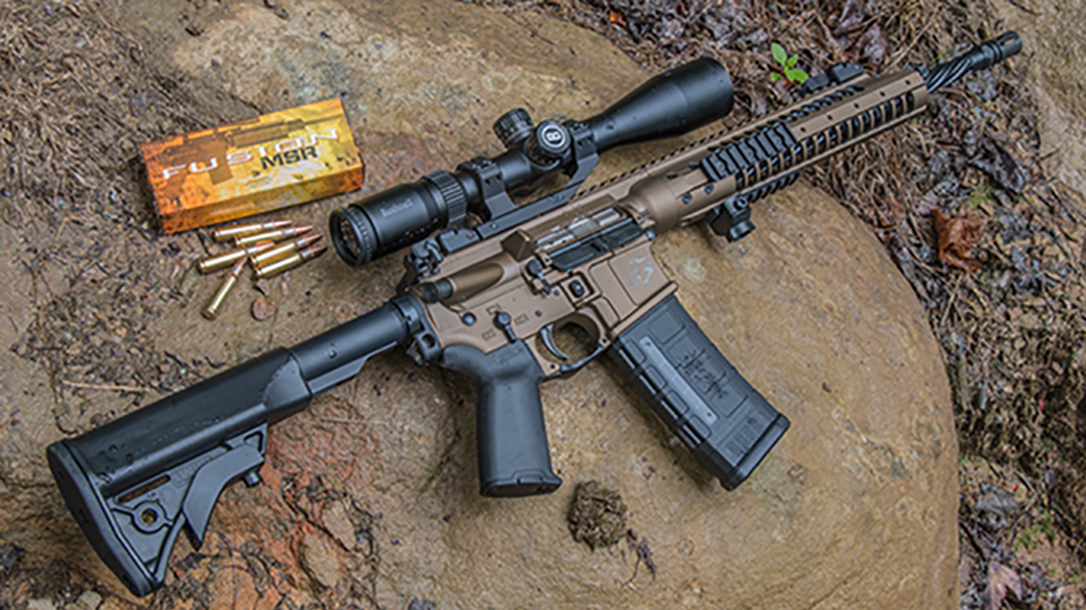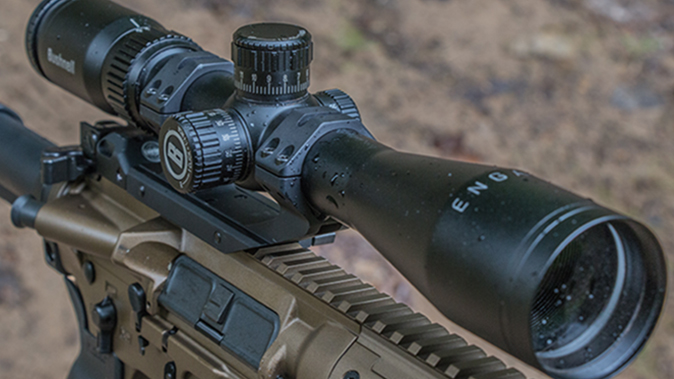For the last 10 years or so, the life of a firearms journalist has been a lot like the movie Groundhog Day—repeatedly reviewing one AR-15 after another. After writing about dozens of ARs, and trying to do so in an educational and entertaining way, I just stopped. This is partly because most modern ARs work very well and partly because they only differ in the parts they’re made of. But I decided to fall off the wagon when I got an opportunity to test the new Six8-A5 Razorback II from LWRC International because, well, it’s different.
Before we get into the rifle, let’s start with the cartridge it was designed to fire. The 6.8 SPC II was developed to address the deficiencies in terminal performance seen with the 5.56mm NATO. Its primary appeal was more power on target without substantial limits on ammo capacity. In short, the 6.8 SPC II was intended to bridge the gap between the 5.56mm and 7.62mm NATO.
However, since its inception, reliable high-capacity magazines for the 6.8 SPC II have been an issue. So, LWRCI designed its Six8 family of weapons around a new magazine designed to alleviate those problems. Through a partnership with Magpul, the first polymer 6.8 SPC II magazines ware created. The Six8 PMAG features many characteristics of standard PMAGs, including the curved shape and familiar texturing. The body is slightly wider, and the walls were strengthened in critical areas. The follower is also red, making these magazines easy to identify.
Advertisement — Continue Reading Below
Do the magazines work? You betcha! I pushed 300 rounds through this rifle to test its accuracy and conduct various drills. I mixed ammunition types, I shot slow, and I shot fast. Essentially, I did everything you could think of to make the rifle puke, but it never even got the least bit sick. In short, this gun and its Magpul magazines are a winning combo.
Razorback Details
With a precision-engineered magazine in hand, it was time to start on the rifle. LWRCI designed the upper and lower receivers to accommodate the slightly larger polymer magazine and to perfect the feeding of the 6.8 SPC II cartridge. As with the entire IC family of LWRCI weapons, those in the Six8 series are fully ambidextrous. This means you can operate the safety lever, magazine release, bolt release and charging handle just as easily with the right or left hand.
Advertisement — Continue Reading Below
Some may be thinking, “I’m right-handed. Why would I need an ambidextrous rifle?” Here’s the thing: Conventional ARs only have the magazine release on the right side, and they only have a bolt release on the left side. In true tactical and even some hunting applications, however, you may need to run your gun from your off-side (left) shoulder. With the Razorback II, you can run the rifle just as efficiently from either side. The ambidextrous nature of the rifle also allows you to manipulate the rifle with either hand, regardless of your situation.
As the name implies, this isn’t the first Razorback from LWRCI. The original differed in that it had a shorter, non-fluted barrel and no adjustable gas block. That rifle was also limited to 500 units. The new Razorback II comes standard with a spiral-fluted barrel and a two-position gas block for suppressed or unsuppressed fire.
These alterations were made at the request of Todd Huey, hog hunter extraordinaire. Huey is an LWRCI pro staffer who is addicted to hog hunting. He used the original Razorback with great success but felt the rifle needed a bit longer barrel and an adjustable gas block to allow uncompromised suppressed shooting. He also wanted the barrel to be fluted to offset some of the weight a suppressor added.
Advertisement — Continue Reading Below
This is probably a good place to mention that this is a piston-driven rifle. Now, some AR aficionados like pistons, and some don’t. From a reliability standpoint, I’ve never really cared either way, but I must admit that I’m somewhat partial to the original direct impingement (DI) operating system. This is mostly because my test records indicate that DI guns are more accurate on average. But, as you will see, no one seems to have told LWRCI that piston-operated guns are less accurate.
What really needs mentioning here is the unique two-piece handguard LWRCI uses on its piston guns. There are two screws at the front end of the handguard. If you loosen these captive screws, you can remove the top of the handguard and access the piston system for maintenance and cleaning. Jeff Clemmer of LWRCI says you can reliably run as many as 5,000 rounds through this rifle without cleaning the piston system. I’d like to tell you I verified this, but even gun writers can’t get that much ammo for free! Additionally, if you have night-vision optics attached, you don’t have to worry about losing your zero when you remove or install the top section.
What You’ll Like
Yes, I’ll admit that the Six8-A5 Razorback II is just another AR for the most part. But it happens to be an AR that is exceptionally well thought out and designed. It’s one of the few ARs I’ve looked at that needs no additional cool stuff added to it right out of the box to make it, well, perfect. I was particularly pleased with the ambidextrous charging handle, which was easy to operate with either hand, even with a traditional scope mounted. I also liked the positioning of the rear sling mount at the intersection of the lower receiver and collapsible buttstock.
Advertisement — Continue Reading Below
The ambidextrous mag release didn’t blow my skirt up, but I really liked the ability to drop the bolt with my right or left trigger finger. Now, some might consider positioning the bolt release close to the magazine release on both sides dangerous. And, I guess it’s not a stretch to drop the magazine instead of the bolt in the heat of the moment. Of course, this is a training issue but deserves mentioning. Still, I’ll take the rifle like it is because I can run it from either shoulder just as easily.
How It Shoots
For accuracy testing, I turned to a riflescope that had proven itself on the range and in the field. What might astound you is that I mounted a $300 riflescope on a nearly $3,000 rifle. This year Bushnell introduced a new line of Engage riflescopes. I took one of the 2.5-10x44mm models to Africa on a sweet-shooting 6.5 Creedmoor rifle and watched my son dial in correction after correction and cleanly take animals out to 600 yards. The combination of 100-percent repeatable adjustments and the Deploy MOA reticle make this an excellent precision scope. Mounted in a quick-detach Weaver mount, it seemed perfect for this rifle.
Advertisement — Continue Reading Below
When I slid in behind the rifle at the bench, I’ll admit that I didn’t expect to be impressed. I’ve tested quite a few 6.8 SPC ARs and wasn’t awestruck by their accuracy. Sure, most of them averaged well under 2 MOA, but I hadn’t seen a tack driver—until now. The first five-shot group I fired with the Razorback II using Silver State Armory ammunition measured 0.88 inches center to center. I fired four more groups, and the average for them all was less than an inch.
In all, I tested five loads in this rifle, and the least precise of them still shot a group that measured less than 1.75 inches. Without question, I feel this rifle is capable of more precision than I can extract from it; I managed to fire at least one group with each load that measured less than an inch. And, this is a 6.8 SPC!
The one thing I didn’t like is the trigger. This was the only feature that reminded me of my old days of testing one AR after another. I assume this is partly because manufacturers assume a good trigger will jack the price up too high, and partly because they assume shooters are going to install a Timney trigger anyway. These assumptions need to stop. If you are going to build a rifle at any price point, put a good trigger in it.
Advertisement — Continue Reading Below
The trigger here required 6 pounds of force to release the hammer. That’s not a deal-breaker. But I didn’t consider this a good trigger because it had a long and mushy take-up that was seemingly as heavy as the weight required to release the hammer.
The Legacy Continues
LWRCI has a great reputation in the field of high-end AR-platform rifles. The new Six8-A5 Razorback II will not detract from that. In fact, it only adds to the LWRCI legacy. I was immensely impressed with the rifle, and after a few weeks of working with it on the range, this is the first time I’ve ever considered adding a 6.8 SPC to my arsenal. This might be the rifle responsible for changing my mind about that cartridge.
In the meantime, I asked LWRCI if I could hold onto the Razorback II a little longer and use it as a test platform for new 6.8 SPC II loads I need to report on. Yes, this rifle is that good, and LWRCI knows it, too.
Advertisement — Continue Reading Below
LWRCI SIX8-A5 Razorback II Specs
| Caliber: 6.8 SPC II |
| Barrel: 16 inches |
| OA Length: 32.25-35.5 inches |
| Weight: 7.25 pounds (empty) |
| Stock: Collapsible |
| Sights: LWRCI Skirmish |
| Action: Piston-operated semi-auto |
| Finish: Burnt bronze Cerakote |
| Capacity: 30+1 |
| MSRP: $1,550 (as tested) |
LWRCI SIX8-A5 Razorback II Performance
| Load | Velocity | Accuracy |
|---|---|---|
| DoubleTap 100 AccuBond | 2,510 | 1.17 |
| Federal 115 Fusion | 2,531 | 1.11 |
| Hornady 120 SST | 2,474 | 1.32 |
| Remington 115 MatchKing BTHP | 2,400 | 1.48 |
| Silver State Armory 100 AccuBond | 2,708 | 0.94 |
*Bullet weight measured in grains, velocity in fps by chronograph and accuracy in inches for five 5-shot groups at 100 yards.
For more information, visit lwrci.com.
Advertisement — Continue Reading Below

































